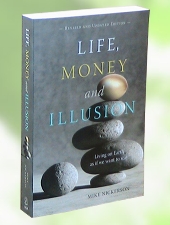The whole story:

Life, Money
and Illusion
One Hand or the Other;
Another way to look at the Question of Direction
The invisible hand of the market is a popular metaphor in economic circles. It asserts that, when each person pursues their own self-interest, they produce the greatest good for society. It claims the invisible hand will lead us to prosperity. Simply allow the market to operate without interference and the reliable characteristic of self-interest will assure optimum results. This phenomena excuses greed because greed is only an intense form of self-interest. In fact, greed stimulates large amounts of economic activity, contributing more to economic expansion than ordinary self-interest.
The other hand is a visible one. It is the hand that guides those who act out of direct concern for others and for the ecological processes of the planet on which we live. This hand beckons us to set our sights consciously on long-term well-being and to apply what we know to solving the variety of problems that are threatening individuals, communities and other living things.
Which hand should we follow?
A Question of Direction calls for a public choice between these options. Which will take precedence when the two perspectives call for different actions?
Two Hands Working Together.
One big lesson we have learned from recent history is about the vigor and resilience of the open market system of economics. "The most important insight that economists have to convey about the market is how independent, decentralized decisions give rise, not to chaos, but to a spontaneous order." Herman Daly and John Cobb
The other big lesson has been how humans are ecologically connected with all life on Earth. "What ecology offers is a way to examine all present economic and resource activities form a biological rather than a monetary point of view, including the impact our present lifestyle will have on generations henceforth." Paul Hawken
- It is possible to learn both these lessons and for the two hands
to work together.
- One way is to adopt something like the Genuine Progress Indicator. Other possibilities are introduced in Making Markets Work for Sustainability.
